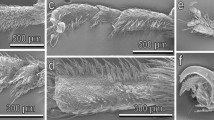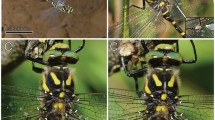Abstract
Portschinskia magnifica (Diptera: Oestridae) is an endangered subcutaneous parasitic fly that is mainly distributed in Eurasia. The external morphology of the main adhesive attachments that include the pretarsus and tarsus is studied using scanning electron microscopy. Two types of tenent setae that are characterised as spoon-like tip and pointed-like tip, which can increase the contact points for attachment to a surface, are described in this study. Hairs around the bristle of the empodium in P. magnifica are much denser than those of other flies, and thus, we proposed that the dense hairs around the empodium may be a more efficient way to perform the sensory function. Compared with saprophagous flies that are reported previously, the microsculpture of the unguitractor plate is obviously different in that microplates are scale-like and similar to those of the water bug, Ranatra linearis. In addition, microtrichia found in the lateral region of the unguitractor plate provides stronger fixation between two surfaces. These results provide anatomical information that allows us to understand the role of the pretarsus as an attachment device.




Similar content being viewed by others
References
Bauchhenss E (1979) Die Pulvillen von Calliphora erythrocephala Meig. (Diptera: Brachycera) als Adhäsionsorgane. Zoomorphology 93:99–123
Bauchhenss E, Renner M (1977) Pulvillus of Calliphora erythrocephala Meig. (Diptera: Calliphoridae). Int J Insect Morphol Embryol 6:225–227
Bullock JMR, Drechsler P, Federle W (2008) Comparison of smooth and hairy attachment pads in insects: friction, adhesion and mechanisms for direction-dependence. J Exp Biol 211:3333–3343
Colwell DD, Otranto D, Stevens JR (2009) Oestrid flies: eradication and extinction versus biodiversity. Trends Parasitol 25:500–504
Corrêa LL, Karling LC, Takemoto RM, Ceccarelli PS, Ueta MT (2013) Hematological alterations caused by high intensity of L3 larvae of Contracaecum sp Railliet & Henry, 1912 (Nematoda, Anisakidae) in the stomach of Hoplias malabaricus in lakes in Pirassununga. São Paulo Parasitol Res 112:2783–2789
Drechsler P, Federle W (2006) Biomechanics of smooth adhesive pads in insects: influence of tarsal secretion on attachment performance. J Comp Physiol A 192:1213–1222
Federle W (2006) Why are so many adhesive pads hairy? J Exp Biol 209:2611–2621
Gaume L, Perret P, Gorb E, Gorb S, Labat JJ, Rowe N (2004) How do plant waxes cause flies to slide? Experimental tests of wax-based trapping mechanisms in three pitfall carnivorous plants. Arthropod Struct Dev 33:103–111
Geim AK, Dubonos SV, Grigorieva IV, Novoselov KS, Zhukov AA, Shapoval SYU (2003) Microfabricated adhesive mimicking gecko foot-hair. Nat Mater 2:461–463
Gorb S, Varenberg M, Peressadko A, Tuma J (2007) Biomimetic mushroom-shaped fibrillar adhesive microstructure. J R Soc Interface 4:271–275
Gorb SN (1996) Design of insect unguitractor apparatus. J Morphol 230:219–230
Gorb SN (1998) The design of the fly adhesive pad: distal tenent setae are adapted to the delivery of an adhesive secretion. Proc R Soc Lond B 265:747–752
Hadwen S (1926) Notes on the life history of Oedemagena tarandi L. and Cephenemyia trompe Modeer. J Parasitol 13:56–65
Klong-Klaew T, Sukontason K, Sribanditmongkol P, Moophayak K, Sanit S, Sukontason KL (2012) Observations on morphology of immature Lucilia porphyrina (Diptera: Calliphoridae), a fly species of forensic importance. Parasitol Res 111(5):1965–1975
Lee H, Lee BP, Messersmith PB (2007) A reversible wet/dry adhesive inspired by mussels and geckos. Nature 448:338–342
Ngern-klun R, Sukontason K, Methanitikorn R, Vogtsberger RC, Sukontason KL (2007) Fine structure of Chrysomya nigripes (Diptera: Calliphoridae), a fly species of medical importance. Parasitol Res 100:993–1002
Niederegger S, Gorb S (2003) Tarsal movements in flies during leg attachment and detachment on a smooth substrate. J Insect Physiol 49:611–620
Niederegger S, Gorb S, Jiao Y (2002) Contact behaviour of tenent setae in attachment pads of the blowfly Calliphora vicina (Diptera: Calliphoridae). J Comp Physiol A 187:961–970
Seifert P, Heinzeller T (1989) Mechanical, sensory and glandular structures in the tarsal unguitractor apparatus of Chironomus ripurius (Diptera: Chironomidae). Zoomorphology 109:71–78
Sukontason KL, Bunchu N, Methanitikorn R, Chaiwong T, Kuntalue B, Sukontason K (2006) Ultrastructure of adhesive device in fly in families Calliphoridae, Muscidae and Sarcophagidae, and their implication as mechanical carriers of pathogens. Parasitol Res 98:477–481
Sukontason K, Narongchai P, Kanchai C, Vichairat K, Sribanditmongkol P, Bhoopat T, Kurahashi H, Chockjamsai M, Piangjai S, Bunchu N, Vongvivach S, Samai W, Chaiwong T, Methanitikorn R, Ngern-Klun R, Sripakdee D, Boonsriwong W, Siriwattanarungsee S, Srimuangwong C, Hanterdsith B, Chaiwan K, Srisuwan C, Upakut S, Moopayak K, Vogtsberger RC, Olson JK, Sukontason KL (2007) Forensic entomology cases in Thailand: a review of cases from 2000 to 2006. Parasitol Res 101(5):1417–1423
Walker G, Yule AB, Ratcliffe J (1985) The adhesive organ of the blowfly, Calliphora vomitoria: a functional approach (Diptera: Calliphoridae). J Zool (Lond) 205:297–307
Wood DM (1987) Oestridae. Manual of Nearctic diptera volume 2 (corrected by Mcalpine JF, Peterson BV, Shewell GE, Teskey HJ, Vockeroth JR & Wood DW), pp. 1147–1158. Monograph 27, Agriculture Canada Research Branch, Ottawa.
Zhang XS, Liang AP (2012) Ultrastructural morphology of the pulvilli in Musca domestica, Bercaea cruentata and Chrysomra pinguis (Diptera). Acta Zootaxon Sin 37:694–700
Zhang D, Wang QK, Hu DF, Li K (2012) Cuticular structures on antennae of the bot fly, Portschinskia magnifica (Diptera: Oestridae). Parasitol Res 111:1651–1659
Acknowledgments
We are grateful to Dr. Jun-na Shi (Beijing Forestry University, Beijing, China) for her invaluable help in this study. This study was supported by the Program for New Century Excellent Talents in University (No. NCET-12-0783), the National Nature Science Foundation of China (No. 31201741), the Chinese Postdoctoral Science Foundation (No. CPSF-20100470009, No. SFG-201104059) and the Fundamental Research Funds for the Central Universities (No. YX2013-08).
Author information
Authors and Affiliations
Corresponding author
Rights and permissions
About this article
Cite this article
Yang, Y.Z., Zhang, D. Adhesive attachments of the endangered botfly, Portschinskia magnifica (Diptera: Oestridae). Parasitol Res 113, 3795–3800 (2014). https://doi.org/10.1007/s00436-014-4046-y
Received:
Accepted:
Published:
Issue Date:
DOI: https://doi.org/10.1007/s00436-014-4046-y




